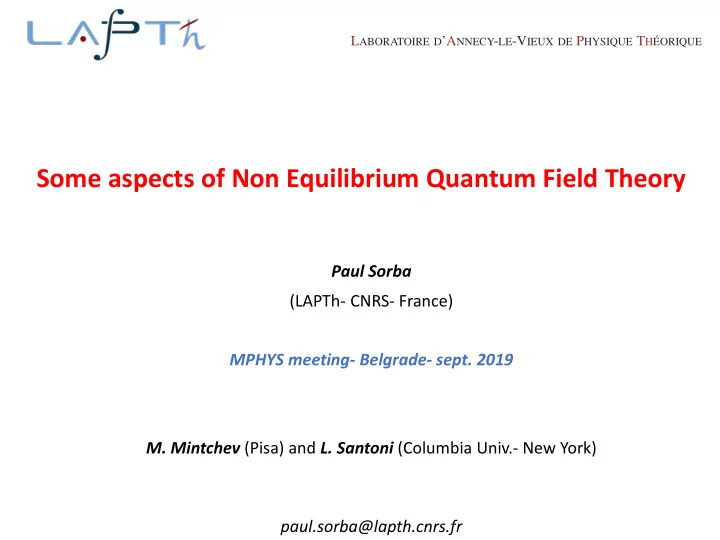

L ABORATOIRE D ’A NNECY - LE -V IEUX DE P HYSIQUE T HÉORIQUE Some aspects of Non Equilibrium Quantum Field Theory Paul Sorba (LAPTh- CNRS- France) MPHYS meeting- Belgrade- sept. 2019 M. Mintchev (Pisa) and L. Santoni (Columbia Univ.- New York) paul.sorba@lapth.cnrs.fr
Some developments of Non Equilibrium Quantum Field Theory considering Quantum wires in the form of Star Graphs Continuation of a program started about 20 years ago with M.Mintchev and other collab. (E.Ragoucy, M.Burrello, B.Bellazzini, L.Santoni): i) Algebraic framework for dealing with defects in 1+1dim., introducing the ‘’reflection- transmission’’ or ‘’R-T’’ algebras, powerful approach to integrable systems with impurities. ii) With spectral theory of Schrodinger operator on quantum graphs, formalism for explicit computations, complete classification of boundary conditions and determination of physical quantities i.e. conductance in different models. (cf. ‘’Quantum Wires’’ seminar at MPHYS 6 (2010)) Quantum networks first applied to electron transport in organic molecules, then appeared in interacting 1 dim. electron gaz. Applications due to rapid progress in nanoscale quantum devises .
iii) Non Equilibrium Quantum Systems with thermal reservoirs at the edges of the network. What we have done: - an explicit construction in field theory of Non Equilibrium Steady States - or NESS, - a study of microscopic features of quantum transport and entropy production. Based on: M. Mintchev, L. Santoni, P.S. [1] J.Phys.A: Math.Theor.48 (2015) 285002; [2] Phys.Rev.E96, 052124 (20170; [3] Annalen der Physyk 530, 201800170 (2018)
Tapez une équation ici.
The solution in absence of bound states of S : ψ ( t, x, i ) = ʃ ∞ dk e − i ω ( k ) t − i kx a ( k ) , ω ( k ) = k 2 i − ∞ 2 π 2 m { a i ( k ) , a j ∗ ( p ) } generate the (anti)commutation relation algebras A ± and satisfy • [ a i ( k ) , a j ∗ ( p )] ± = 2 π [ δ ij δ ( k − p ) + S ij ( k ) δ ( p + k ) ] . * ( k ) = a j * (- k ) S ji (- k ) constraints: a i ( k ) = S ij ( k ) a i (- k ) ; a i • interaction codified in the algebra - greatly simplifies the analysis; • observables: • particle current i ∗ ∗ [ ψ ( ∂ ψ ) − ( ∂ ψ ) ψ ] ( t, x, i ) ; j ( t, x, i ) = x x x 2 m • energy current θ xt ( t, x, i ) = [( ∂ ψ ) ( ∂ ψ ) + ( ∂ ψ ) ( ∂ ψ ) − ( ∂ ∂ ψ ) ψ − ψ ( ∂ ∂ ψ )]( t, x, i ) ; ∗ ∗ ∗ ∗ 1 4 m t x x t t x t x ˙ q x ( t, x, i ) = θ xt ( t, x, i ) − µ i j x ( t, x, i ) ; • heat current β i q x ( t, x, i ) S ( t, x ) = − • Σ entropy production operator i =1,2 • fix a representation of A ± .
Algebraic construction of the NESS:
Further developments: Non-equilibrium quantum thermodynamics - a new branch of quantum physics ˙ Basic open question - properties of the operator S (quantum second law?). Lesson from this investigation: study the probability distribution ρ [ S ˙ ]: Test other models and non-equilibrium states. extend the above analysis to finite frequencies ν > 0: • • experimental progress - Kolkowitz et al, Science (2015), Tikhonov et al, Nature Sci. Rep. (2016), Weng et al, Science (2018); partial theoretical progress - a bound state with energy − ω b < 0 hasa • specific impact on the particle noise at frequency ν > ω b ; bound state spectroscopy – Mintchev, Santoni, S. (2017); • analyse more general domains D = [ a , b ] and D = R: • statistical interaction - anyon Tomonaga-Luttinger liquid: - quantum transport of anyon fluid in R – Mintchev, S. (2013). • Lieb-Liniger model in R (integrability): Calabrese et al. (2018) the distribution ρ [ ψ ∗ ψ ] - turns out to be a Dirac comb; ρ [ S ˙ ] - still an open problem;
Many thanks for your attention
Recommend
More recommend